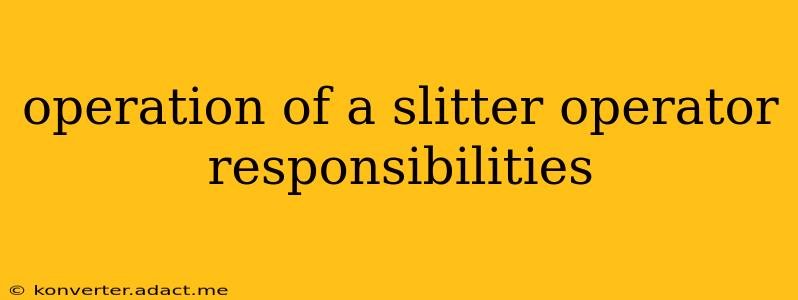A slitter operator plays a crucial role in the manufacturing process, particularly in industries dealing with rolls of materials like paper, film, foil, and fabric. This role requires a blend of technical skills, attention to detail, and a commitment to safety. This comprehensive guide delves into the key responsibilities of a slitter operator, addressing common questions and offering insights into this essential manufacturing position.
What are the main responsibilities of a slitter operator?
The primary responsibility of a slitter operator is to operate and maintain the slitting machine, ensuring the production of high-quality, accurately sized rolls of material. This involves a multifaceted approach, encompassing several key tasks:
- Setting up the slitter: This includes configuring the machine based on the order specifications, adjusting blade spacing, and setting the rewinding tension. Precision is paramount here, as incorrect settings can lead to product defects.
- Operating the slitter: This involves monitoring the machine during operation, adjusting settings as needed to maintain consistent quality and speed, and ensuring the smooth flow of material. Constant vigilance is necessary to identify and address any potential issues.
- Quality control: A slitter operator is responsible for inspecting the slit rolls for defects, such as uneven cuts, wrinkles, or tears. Rejecting substandard rolls is a critical part of maintaining product quality.
- Maintenance: Basic preventative maintenance tasks, like cleaning the machine and replacing worn blades, are often within the operator's responsibilities. Reporting more significant maintenance needs to the appropriate personnel is also crucial.
- Safety: Adhering to all safety regulations and using appropriate personal protective equipment (PPE) is non-negotiable. Safe operation of the slitter is paramount.
- Record Keeping: Maintaining accurate production records, including roll counts, material usage, and any encountered issues, is essential for tracking efficiency and identifying areas for improvement.
What skills are needed to be a slitter operator?
Beyond the operational aspects, several key skills contribute to a slitter operator's success:
- Mechanical aptitude: Understanding the mechanics of the slitter and how its various components interact is fundamental.
- Problem-solving skills: Identifying and resolving issues that arise during operation requires quick thinking and analytical skills.
- Attention to detail: Precision is critical in this role; even small errors can impact product quality.
- Physical stamina: The job can be physically demanding, requiring prolonged standing and lifting.
- Teamwork: Effective collaboration with other team members, including supervisors and maintenance personnel, is crucial for smooth operation.
What is the difference between a slitter and a rewinder?
While often used together, a slitter and a rewinder serve distinct functions. The slitter cuts a wide roll of material into narrower rolls, whereas the rewinder rewinds the slit material onto smaller cores. Many machines combine both functions, but the underlying processes are different.
How do I become a slitter operator?
Entry-level positions often require minimal formal education, though prior experience in a manufacturing setting or related field is often advantageous. On-the-job training is common, with experienced operators guiding new employees through the intricacies of machine operation and maintenance. Some companies may offer apprenticeship programs.
What is the job outlook for slitter operators?
The job outlook for slitter operators is generally considered stable, driven by consistent demand across various industries. However, technological advancements may lead to some automation in the future, potentially impacting the need for manual operators.
What are the safety precautions for a slitter operator?
Safety is paramount. Slitter operators should always use appropriate PPE, including safety glasses, hearing protection, and gloves. Regular machine inspections are crucial, and any potential hazards should be reported immediately. Following established safety protocols and lockout/tagout procedures are essential.
By mastering these responsibilities and cultivating the necessary skills, a slitter operator can contribute significantly to the efficiency and success of a manufacturing operation. The role demands precision, dedication, and a commitment to safety—all essential ingredients for producing high-quality products.
